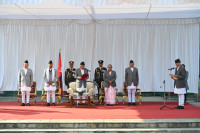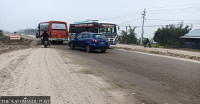National
Despite quotas, hill Brahmins disproportionately land civil service jobs
In fiscal year 2019-20, 28 percent of applications for civil service jobs were from the community but 45 percent of those recruited were from it. This has been a trend for past few years.
Prithvi Man Shrestha
Despite mandatory reservation for marginalised groups, including women, in the civil service as per the Civil Service Act 2007, hill Brahmins continue to be the group most interested in civil service jobs and recruited in it compared to their share in the country’s population.
Of total applications in the fiscal year 2019-20 for the jobs under federal government, as many as 28 percent were received from the hill Brahmin community, according to the 61st annual report of the Public Service Commission. The total applications received from this community was 126,430 against total applications of 451,526.
When it comes to recommendation for recruitment, 45 percent of those recommended were the Bramhins, according to the commission. Of the 304 recommended in 2019-20, 137 were from the hill Bramhin community.
Due to the coronavirus pandemic, the commission is yet to take exams to fill the majority of vacancies in the civil service with a total 10,368 vacancies announced in the last fiscal year.
According to population census 2011, the population of hill Bramhins is just 12.17 percent.
Umesh Mainali, chair of the Public Service Commission responsible for recruiting civil servants, said the reason many from the community seek to enter the civil service is because of the legacy of the group in the civil service.
“Since there is a presence of a large number of hill Bramins in the civil service, people from this community are influenced by families and friends to join the service and they prepare accordingly,” he said. “People from other communities however don’t have a tendency of focussing only on civil service jobs.”
The second highest applications (17.94 percent) were received from Chhetris, and the third highest from Tharus (6.61 percent) in the last fiscal year, according to the commission. Chettris make up 16.59 percent of the total population, the largest single category, while Tharus make up 6.55 percent of the population.
In 2019-20, as many as 12.83 percent of the jobs went to Chettris while 4.61 percent went to Tharus.
Applications from hill Brahmins have been on the rise for the last few years according to data of the commission. In fiscal year 2016-17, the proportion of the applications from them of the total stood at 24.89 percent, rising to 26.47 percent in 2017-18 and to 27.71 percent in 2018-19.
The total number of those recommended for recruitment, 22.96 percent of total were hill Brahmins in 2016-17, 33.39 in 2017-18 and 34.87 percent in 2018-19.
In fiscal year 2018-19 recruitment of Chhetris stood second with 19.63 percent percent. Although Magars (7.12 percent), Tharus (6.55 percent) and Tamangs (5.81 percent) have third, fourth and fifth largest populations, recruitment of these communities stood at 5.03 percent, 3.91 percent and 1.36 percent respectively in fiscal year 2018-19.
In line with the commitments made by the major political parties for inclusive development, while ending the decade-long Maoist insurgency and the subsequent Madhes movement, the Civil Service Act was drafted with provisions for reservations for women and various marginalised communities.
While filling the vacant posts for section officers, 70 percent of total vacant posts are filled through open competition while 30 percent is filled through promotions for section officers. From the category where open competition is held, 45 percent is set aside for a separate competition among different clusters of communities for the purpose of inclusion.
The Civil Service Act 2007 mandates that as much as 45 percent of new recruits in civil service jobs must be for marginalised communities.
As per the law, from the inclusion quota, 33 percent seats are reserved for women, 27 percent for indigenous nationalities, 22 percent for Madhesis, 9 percent for Dalits, 5 percent for the disabled, and 4 percent for backward regions. The remaining 55 percent of seats are filled through open competition.
According to Mainali, after the policy of inclusion was adopted in 2007, the presence of the other communities including women have grown significantly.
Officials and activists working for the rights of marginalized admit that inclusion policy has helped to grow the presence of marginalised communities in the recent years. Particularly, the presence of women in the civil service has visibly grown as they can compete from both the quota of women as well as from that for other marginalized communities.
Women’s representation in the civil service was 11 percent in the fiscal year 2007-08, which increased to around 25 percent in the fiscal year 2018-19, according to the Department of Civil Personnel Records
But, composition of the civil service has not changed drastically when it comes to representation of other marginalised communities.
Despite being confined within the open category only, recruitment from the hill Bramhin community has continued to remain disproportionately high compared to their population.
“Although the total recruitment of Bramhins in civil service is disproportionately high compared to their population, the portion of those recruited from the community would be even higher under free competition,” said Devi Subedi, information officer at the commission.
Marginalised groups also compete from the open category as well as other non-marginalised groups like Chettris.
But since exams have not been held for most of the vacant seats because of the pandemic, officials said that the recruitment in fiscal year 2019-20 does not reflect the true representation of different communities.
According to former chief secretary Bimal Koirala, people from hill Bramhin community have not traditionally sought to seek employment outside the civil service for employment and that is why they are disproportionately represented in the civil service.
“Their upbringing happens in the families of civil servants which create an environment for them to go to the civil service,” he said. “When it comes to other communities, they are comfortable with other jobs as well because of lack of heritage in civil service.
But, activists fighting for the rights of marginalised people say that there is a growing tendency among the state agencies to issue vacancy notices in small numbers to avoid inclusion criteria.
“If a state agency issues a vacancy notice for one or two posts, it becomes difficult to ensure inclusion,” said Gobinda Chhantyal, vice-chairperson of Nepal Federation of Indigenous Nationalities, an advocacy group for indigenous rights. “Despite the need for a high number of human resources, vacancies are issued in fragmented ways deliberately. In the small office, maintaining inclusion is difficult because of the limited number of staff required.”
In 2019, recruitment drives of over 9161 staff for the local governments had landed into controversy because several vacancies notices were issued that made it difficult for ensuring 45 percent representation for marginalized communities.
If the representation of different marginalised communities in the civil service is to be increased, more should apply for jobs in it, according to Koirala.
“Convincing them to focus on civil service jobs is necessary to increase their participation in civil services in addition to inclusion policy,” said Koirala.




 19.12°C Kathmandu
19.12°C Kathmandu















